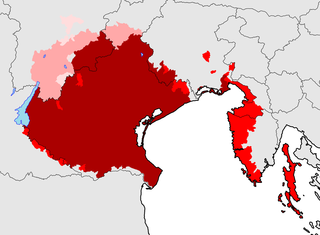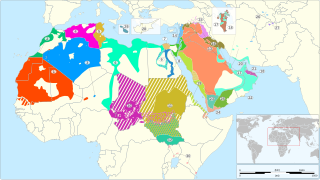Related Research Articles

Yiddish is a West Germanic language historically spoken by Ashkenazi Jews. It originates from 9th century Central Europe, providing the nascent Ashkenazi community with a vernacular based on High German fused with many elements taken from Hebrew and to some extent Aramaic. Most varieties of Yiddish include elements of Slavic languages and the vocabulary contains traces of Romance languages. Yiddish has traditionally been written using the Hebrew alphabet; however, there are variations, including the standardized YIVO orthography that employs the Latin alphabet.

The Gallo-Romance branch of the Romance languages includes in the narrowest sense the langues d'oïl and Franco-Provençal. However, other definitions are far broader and variously encompass the Occitan or Occitano-Romance, Gallo-Italic or Rhaeto-Romance languages.

Venetian, wider Venetian or Venetan is a Romance language spoken natively in the northeast of Italy, mostly in Veneto, where most of the five million inhabitants can understand it. It is sometimes spoken and often well understood outside Veneto: in Trentino, Friuli, the Julian March, Istria, and some towns of Slovenia, Dalmatia (Croatia) and Bay of Kotor (Montenegro) by a surviving autochthonous Venetian population, and in Argentina, Australia, Brazil, Canada, Mexico, the United States and the United Kingdom by Venetians in the diaspora.

Jewish languages are the various languages and dialects that developed in Jewish communities in the diaspora. The original Jewish language is Hebrew, supplanted as the primary vernacular by Aramaic following the Babylonian exile. Jewish languages feature a syncretism of Hebrew and Judeo-Aramaic with the languages of the local non-Jewish population.

Judeo-Arabic dialects are ethnolects formerly spoken by Jews throughout the Arab world. Under the ISO 639 international standard for language codes, Judeo-Arabic is classified as a macrolanguage under the code jrb, encompassing four languages: Judeo-Moroccan Arabic (aju), Judeo-Yemeni Arabic (jye), Judeo-Egyptian Arabic (yhd), and Judeo-Tripolitanian Arabic (yud).
Judeo-Italian is an endangered Jewish language, with only about 200 speakers in Italy and 250 total speakers today. The language is one of the Italian languages and one of the Jewish Romance Languages. Some words have Italian prefixes and suffixes added to Hebrew words as well as Aramaic, roots. All of the language's dialects except one are now extinct.

Judaeo-Aramaic languages represent a group of Hebrew-influenced Aramaic and Neo-Aramaic languages.

Judeo-Tat or Juhuri is a Judeo-Persian dialect of the Tat language historically spoken by the Mountain Jews, primarily in Azerbaijan, Dagestan, and today in Israel. It belongs to the southwestern group of the Iranian division of the Indo-European languages with heavy influence from the Hebrew language. In the era of Soviet historiography, the Mountain Jews were mistakenly considered to be related to the Muslim Tats of Azerbaijan. However, they do not share a common linguistic heritage, as the Mountain Jews kept their native language, while the Muslim Tats eventually adopted Persian. The words Juvuri and Juvuro translate as "Jewish" and "Jews".
Judeo-Hamadani and Judeo-Borujerdi constitute a Northwestern Iranian language, originally spoken by the Iranian Jews of Hamadan and Borujerd in western Iran. Hamadanis refer to their language as ebri "Hebrew" or zabān-e qadim "old language". Though not Hebrew, the term ebri is used to distinguish Judeo-Hamadani from Persian.
In 1920, Hamadan had around 13,000 Jewish residents. According to members of the community that Donald Stilo encountered in 2001-02, there were only eight people from the Jewish community left in Hamadān at the time, but others can still be found in Israel, New York City, and most predominantly in Los Angeles.
Judaeo-Romance languages are Jewish languages derived from Romance languages, spoken by various Jewish communities originating in regions where Romance languages predominate, and altered to such an extent to gain recognition as languages in their own right. The status of many Judaeo-Romance languages is controversial as, despite manuscripts preserving transcriptions of Romance languages using the Hebrew alphabet, there is often little-to-no evidence that these "dialects" were actually spoken by Jews living in the various European nations.

The Gallo-Italic, Gallo-Italian, Gallo-Cisalpine or simply Cisalpine languages constitute the majority of the Romance languages of northern Italy: Piedmontese, Lombard, Emilian, Ligurian, and Romagnol. In central Italy they are spoken in the northern Marches ; in southern Italy in some language islands in Basilicata and Sicily.

Italo-Western is, in some classifications, the largest branch of the Romance languages. It comprises two of the branches of Romance languages: Italo-Dalmatian and Western Romance. It excludes the Sardinian language and Eastern Romance.

Yiddish dialects are varieties of the Yiddish language and are divided according to the region in Europe where each developed its distinctiveness. Linguistically, Yiddish is divided in distinct Eastern and Western dialects. While the Western dialects mostly died out in the 19th-century due to Jewish language assimilation into mainstream culture, the Eastern dialects were very vital until most of Eastern European Jewry was wiped out by the Shoah.
Emilian is a Gallo-Italic unstandardised language spoken in the historical region of Emilia, which is now in the western part of Emilia-Romagna, Northern Italy.

Varieties of Arabic are the linguistic systems that Arabic speakers speak natively. Arabic is a Semitic language within the Afroasiatic family that originated in the Arabian Peninsula. There are considerable variations from region to region, with degrees of mutual intelligibility that are often related to geographical distance and some that are mutually unintelligible. Many aspects of the variability attested to in these modern variants can be found in the ancient Arabic dialects in the peninsula. Likewise, many of the features that characterize the various modern variants can be attributed to the original settler dialects as well as local native languages and dialects. Some organizations, such as SIL International, consider these approximately 30 different varieties to be separate languages, while others, such as the Library of Congress, consider them all to be dialects of Arabic.
The Italo-Dalmatian languages, or Central Romance languages, are a group of Romance languages spoken in Italy, Corsica (France), and formerly in Dalmatia (Croatia).

Guido Bedarida was an Italian Jewish writer. He is notable for being the main source of Judeo Livornese literature.
Judeo-Roman or Italkit is the only still living dialect of the Judeo-Italian languages, historically used by the Jews living in Rome. It is spoken by 250 people, most of whom live in Italy. The language is on the decline and most of its remaining speakers are elderly. There are efforts to preserve the language and keep it from extinction.
Judeo-Livornese/Baggito (Italian: Giudeo-Livornese/Bagitto) is an extinct dialect of the Judeo-Italian languages, historically spoken by the Jewish community in and around Livorno. It was heavily influenced by Judeo-Portuguese, Judeo-Italian, Ladino. It is best attested through the works of Guido Bedarida.
References
- ↑ Maddelena Colasuonno, Maria (2018). "Modern Judeo-Italian in the Light of Italian Dialectology and Jewish Interlinguistics through Three Case Studies: Judeo-Mantuan, Judeo-Venetian, and Judeo-Livornese". Jewish Languages in Historical Perspective: 124.
- ↑ "The Linguasphere Register". linguasphere.info. Retrieved 2023-12-29.
- ↑ "Judeo-Italian: Italian Dialect or Jewish Language?". www.jochnowitz.net. Retrieved 2023-12-29.
- 1 2 3 4 5 Maddalena Colasuonno, Maria (2018). "Modern Judeo-Italian in the Light of Italian Dialectology and Jewish Interlinguistics through Three Case Studies: Judeo-Mantuan, Judeo-Venetian, and Judeo-Livornese". Jewish Languages in Historical Perspective: 129.
- 1 2 3 4 "Mantua – j-Italy" . Retrieved 2023-12-30.
- 1 2 3 "Judeo-Italian". Jewish Languages. Retrieved 2023-12-30.
- ↑ "Modern Judeo-Italian in the Light of Italian Dialectology and Jewish Interlinguistics through Three Case Studies: Judeo-Mantuan, Judeo-Venetian, and Judeo-Livornese". Jewish Languages in Historical Perspective: 132. 2018.
- ↑ "Judeo Italian". www.jochnowitz.net. Retrieved 2023-12-30.
- ↑ "Modern Judeo-Italian in the Light of Italian Dialectology and Jewish Interlinguistics through Three Case Studies: Judeo-Mantuan, Judeo-Venetian, and Judeo-Livornese". Jewish Languages in Historical Perspective: 125–126. 2018.
- ↑ "Modern Judeo-Italian in the Light of Italian Dialectology and Jewish Interlinguistics through Three Case Studies: Judeo-Mantuan, Judeo-Venetian, and Judeo-Livornese". Jewish Languages in Historical Perspective: 152. 2018.
- 1 2 "Judeo Italian". www.jochnowitz.net. Retrieved 2023-12-29.